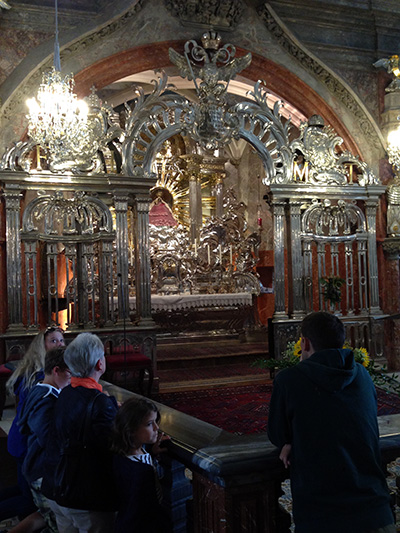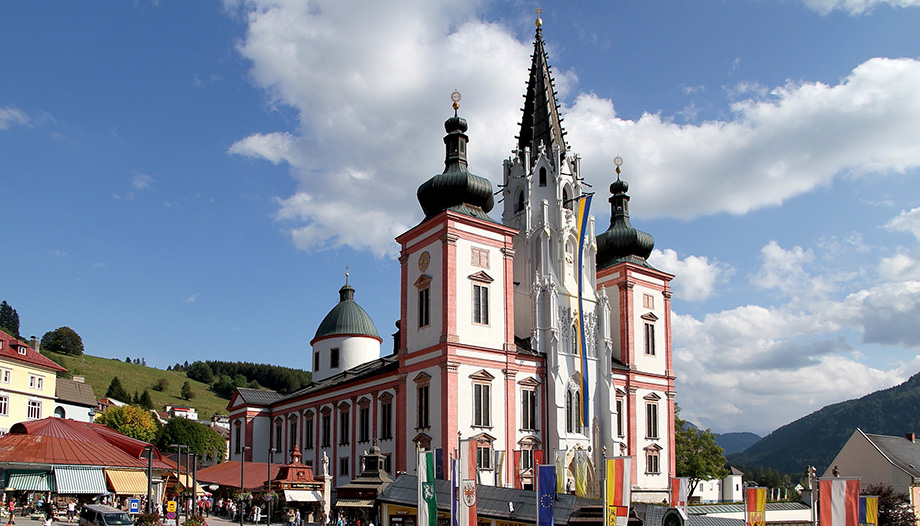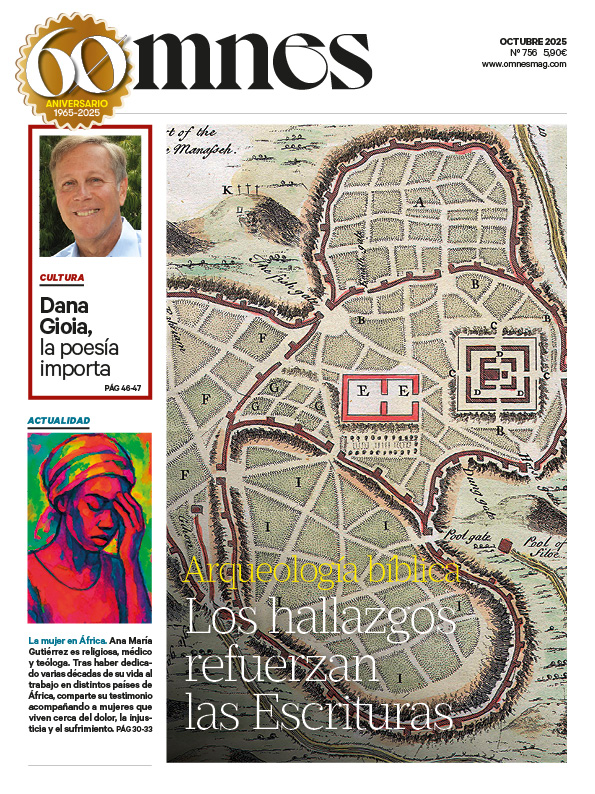According to tradition, around 1157 Abbot Otker of the Benedictine monastery of St. Lambert sent one of his monks to what later became known as Mariazell, then part of the monastery's domain, to take care of the souls of the inhabitants of the area.
With the abbot's approval, Brother Magnus set out on his journey, carrying with him a small figure of the Virgin and Child carved in lime wood. On the night of December 21, while he was on his way to his destination, a large rock appeared in the road, preventing him from continuing his journey.
As he turned to the Virgin for help, the rock split in two and left the way clear. When he finally reached his destination, Brother Magnus set about building a small cell (ZellThe name seems to have been derived from this small room, which served as his lodging as well as a place of prayer. It is from this small room that it seems to derive its name; Maria by the carving that the monk brought with him, and Zell by the cell where it was located at the beginning: Mariazell.
Romanesque temple, Gothic extension
However, according to the inscription above the main portal, it seems that the first Romanesque church was not built until 1200, almost half a century after her arrival. Throughout the following years, the fame of the place spread thanks to the numerous faithful to whom the Virgin granted her graces, becoming the place of pilgrimage par excellence for the inhabitants of the Austrian territories. This was helped by the granting of a plenary indulgence by Pope Boniface IX in 1399, which favored the development of celebrations and processions, which survived even in spite of the religious restrictions imposed by Emperor Joseph II (1765-1790).

The geographical location of the sanctuary undoubtedly favored that throughout the 15th century Mariazell was not only a place frequented by inhabitants of the Austrian area, but also by French, Swiss, Germans, Bohemians, Poles, Hungarians, Croatians or Serbs. This is the main reason why a Gothic-style extension was built on the original Romanesque church. It seems that this began with the addition of a choir and continued with the construction of a new central nave and two side aisles.
But not only the "common people" would go to Mariazell to implore the intercession of the Virgin or in thanksgiving for favors granted. The imperial family would also become protectors and devotees of the Mother of Mariazell, especially after the Counter-Reformation. It was then that an extension of the Gothic church became necessary, which was largely sponsored by the Habsburgs. The reconstruction and enlargement began in 1644, under the direction of the builder Domenico Sciassia. It was not until forty years later that the colossal project, which Sciassia would never see completed, was finished. The immense work and the challenges involved in combining the Gothic elements with the new Baroque introductions have made Mariazell an architectural jewel and the largest church in Austria.
Among the most difficult parts of the church is the facade, which manages to combine the great pointed portal and the original Gothic tower that, according to tradition, was built by the Hungarian King Ludwig I, and the two Baroque towers designed by Sciassia. A fact that goes unnoticed, but that was a way to honor also the Hungarians, regular pilgrims to Mariazell.
Dangers and difficulties
It was in those years of great change and movement that Emperor Leopold I visited the shrine and named the Virgin of Mariazell generalissima of his imperial army. The year was 1676 and, at that time, the Austrian territories needed all the help they could get, due to the constant threat and progressive advance of the Ottoman troops towards the Habsburg territories. An enemy that over the years had become a permanent danger, which would not subside until 1683 when, thanks to the military genius of Prince Eugene of Savoy, they managed to stop the siege of Vienna, expel them from the Austrian territories and put an end to their hegemony in southeastern Europe.
As mentioned at the beginning, the fame of Mariazell managed to survive even the restrictive laws of the enlightened emperor Joseph II and popular piety, although no longer encouraged by the monarchy, continued to see the Virgin of Mariazell as its protector.
Throughout the 19th century the sanctuary would not undergo any further enlargements, but it did have to be deeply restored due to the damage caused by the great fire that occurred on the night of All Saints' Day in 1827. Given its importance, there were numerous financial contributions that helped its rapid restoration between 1828 and 1830. However, the previous plans were not followed, but rather a greater simplification of the construction was sought. Lessons learned, lightning rods were installed for the first time on the roof of the church. Although the damage was extensive, the Romanesque statuette of the Virgin was saved and remains today in its original place, the Chapel of Grace, the heart of the sanctuary. The chapel has become the oldest part of the temple (1690) and contains the 48-centimeter carving of the Virgin and Child, which today is honored as the Magna Mater Austriae and with which Brother Magnus would begin his evangelical work in 1157. Well into the 20th century, the church would be elevated by the Pope to the category of minor basilica in 1907.
Visited by Popes

A few years after being elected Pontiff, St. John Paul II visited Mariazell on September 13, 1983. Years later, his successor, Benedict XVI would return on September 8, 2007 to celebrate the 850th anniversary of the shrine and honor the site with the papal award of the "Golden Rose", a flower forged in gold and filled with aromatic essences such as balsam, incense and holy water. Other shrines that received this same honor, at the time under John Paul II, were Loreto, Lourdes and Czestochowa.
In the homily preached at the time, Benedict XVI spoke about the meaning of the pilgrimage and its relationship with Christ and his Church. But also of that Child God in the arms of his Mother, who at the same time is crucified on the main altar: "We must contemplate Jesus as we see him here in the shrine of Mariazell. We see him in two images: as a child in the arms of his Mother and, on the main altar of the basilica, crucified. These two images in the basilica tell us: truth does not assert itself by external power, but is humble and only gives itself to man by its inner strength: by the fact that it is true. Truth proves itself in love".
Although at times transmitting this message and preaching it in a world hostile to the love of God can be hopeless. Let us not lose heart, as Benedict XVI expressed so well in that same homily: "To go on pilgrimage means to be oriented in a certain direction, to walk towards a goal. This confers a beauty of its own on the journey and the weariness it entails".







